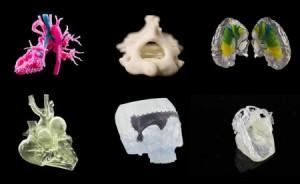Materialise CEO Calls for Improved Clinical Measurement Standards to Help Expand Medical 3D Printing
 There’s no denying that 3D printing technology is steadily changing the shape of the medical industry, whether it be through anatomical models, guides, implants, or the many other applications that continue to become more widely accepted and used in healthcare services across the world. One of the top providers of the healthcare-driven 3D printing revolution is the Leuven, Belgium-based Materialise NV. Focused on academia, medical device companies, and the hospital environment, Materialise has gained quite a stronghold on the medical industry over the past few years.
There’s no denying that 3D printing technology is steadily changing the shape of the medical industry, whether it be through anatomical models, guides, implants, or the many other applications that continue to become more widely accepted and used in healthcare services across the world. One of the top providers of the healthcare-driven 3D printing revolution is the Leuven, Belgium-based Materialise NV. Focused on academia, medical device companies, and the hospital environment, Materialise has gained quite a stronghold on the medical industry over the past few years.
Last year, we covered the service bureau’s partnership with medical product development company Kapstone Medical, as well as a five-year deal with Japan’s Medical Dynamic Marketing, Inc., who partnered with Materialise for 3D printed hip replacements. Their biomedical software, called the Mimics Innovation Suite, is respected across the industry for its quality patient-specific 3D modeling capabilities. Just recently, Mimics proved itself ready-and-able to help provide successful thyroplasty surgery to trans women , and has also just become the go-to 3D modeling software for the Japan-based healthcare provider Canon Lifecare Solutions.
So it seems safe to say that Materialise is the proper leader for creating more generally accepted measurement standards for medical-based 3D printing, and their CEO, Fried Vancraen, is calling for an experienced initiative to develop this tightened approach. With a globally accepted set of guidelines, the medical 3D printing industry can better persuade physicians, hospitals, and policy makers to adopt this increasingly valuable technology. With a developed set of clinical measurement standards for the medical use of 3D printing, government bodies and insurance companies are also more likely to add medical 3D printing to their approved list of medical procedures and devices, which will allow patients access to the most modern, technologically-driven healthcare solutions.
“There have been several initiatives aimed at properly measuring and validating the clinical benefits of medical 3D Printing, but all have suffered from a lack of coordination and agreed-upon research methodologies,” Vancraen stated. “The fact is, we can only be successful if we take an evidence-based approach across the industry, acting in concert with a set of protocols, methodologies and measurement guidelines. With the proper scientific rigor, our ambition of gaining widespread acceptance of medical 3D Printing will be realized more swiftly, and the patients whom we aim to serve will benefit the most.”
To help jumpstart the initiative, Materialise will lead the way by studying and designing an evidence-based approach to create these clinical standards, which will include an economical, clinical, engineering and patient-based focus. According to Vancraen, Materialise’s goal is to set the groundwork for more solid measurements, which will help validate a variety of medically-driven 3D printing applications, including anatomical models, patient-specific guides, and implants. With these plans, Materialise can help ingrain 3D printing technology even more deeply into the medical industry by producing more solid clinical evidence, which should further incline physicians, hospitals, and other medical organizations to implement 3D printing into their own healthcare services.
Materialise will be presenting this on-going initiative at Building Evidence for 3D Printing Applications in Medicine, an event hosted by SME and sponsored by Materialise. This event will follow the RAPID Conference, an annual 3D printing conference that will take place at the Orange County Convention Center in Orlando, Florida from May 19-20. If you’d like to learn more about this well-rounded approach to creating better clinical measurement standards for 3D printing, you can either register for the upcoming event or—for those not in the vicinity of the in-person discussion—request more information from the Materialise website. Discuss in the Materialise 3D Printing and Clinical Evidence forum over at 3DPB.com.
[Source: Materialise NV via Ortho Spine News]
Subscribe to Our Email Newsletter
Stay up-to-date on all the latest news from the 3D printing industry and receive information and offers from third party vendors.
Print Services
Upload your 3D Models and get them printed quickly and efficiently.
You May Also Like
The Market and Industry Potential of Multi-Material 3D and 4D Printing in Additive Electronics
Additive manufacturing leverages computer-based software to create components for products by depositing either dielectric or conductive materials, layer by layer, into different geometric shapes. Since its birth in the 1980s,...
3DPOD 262: Bio-inspired Design for AM with Dhruv Bhate, Arizona State University
Dhruv Bhate is an associate professor at Arizona State University. There, he looks at structures, materials, and design. Previously, he worked at PADT as well as in the semiconductor and...
3DPOD 261: Tooling and Cooling for AM with Jason Murphy, NXC MFG
Jason Murphy´s NXC MFG (Next Chapter Manufacturing) is not a generalist service; instead, the company specializes in making tooling. Using LPBF and binder jet, the company produces some of the...
3DPOD 260: John Hart on VulcanForms, MIT, Desktop Metal and More
John Hart is a Professor at MIT; he´s also the director of the Laboratory for Manufacturing and Productivity as well as the director of the Center for Advanced Production Technologies....


































